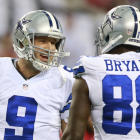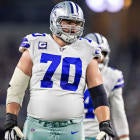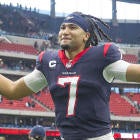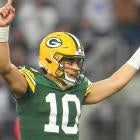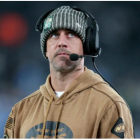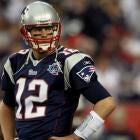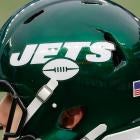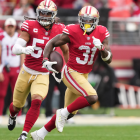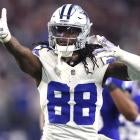Over the next eight days, we will be unveiling our All-Division teams here at CBSSports.com. What does that entail? We're picking a quarterback, two running backs, three wide receivers, two tight ends, five offensive linemen, two defensive ends, two defensive tackles, four linebackers, three cornerbacks and two safeties from each division that we believe will have the best 2016 season. Over the last few weeks, we've narrowed down the final roster, and we'll present them in this space. We'll start today with the NFC East.
Quarterback: Tony Romo, Cowboys
The first call we had to make was undoubtedly the toughest. You could easily make a pretty good case here for either Eli Manning or Kirk Cousins, but in the end it's Romo's upside and consistency that got him the nod.
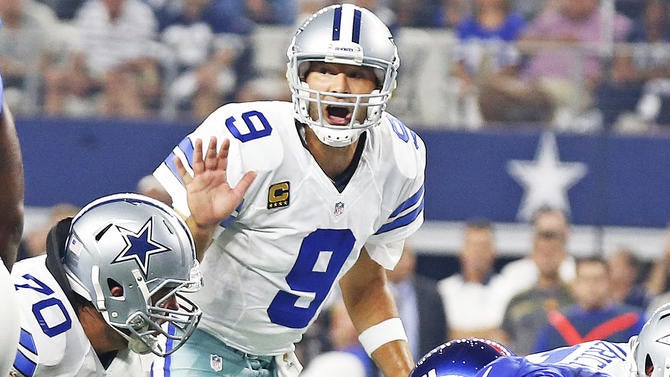
Yes, Cousins led the NFL in completion percentage last season and pulled off a fairly stunning reversal of his touchdown-to-interception ratio (29-11 last year; 18-19 before that), but he has only one good NFL season under his belt. There are reasons to think he'll produce as well as he did last season, but expecting him to outperform Manning and/or Romo, who have far longer track records, is no sure bet.
Eli has those two Super Bowl rings on his fingers and because of that, there are some people that will refuse to acknowledge the idea that Romo could possibly ever have a better season than him. But we're not here to talk about the past, and even with his improved numbers in Bob McAdoo's offense, Eli's efficiency has not approached the level Romo typically hits.
Eli has set career-highs in completion percentage the last two years. In only one of Romo's 10 seasons did he have a completion mark worse than either of those two seasons Eli just posted. And Eli's career-high passer rating in 2015 has been topped by Romo in seven of his nine seasons.
Romo, meanwhile, led the NFL in completion percentage, yards per attempt, touchdown percentage (touchdowns/passes), passer rating, and QBR during his last healthy season. The Cowboys plan on getting back to the run-heavy, ball-control, protect-Romo offense, and as long as he stays on the field, that should work out exceedingly well for him. Add in a running back that is not only an excellent receiver out of the backfield but also an ace pass-blocker, and he should be in for a good year.
Running Backs: Ezekiel Elliott, Cowboys; Ryan Mathews, Eagles
There aren't many rookies on any of our All-Division teams, but it's difficult to picture a rookie being put in a better position to succeed in his first year than Elliott. One of the most talented running backs to come out of college in the last decade, he gets to run behind the NFL's best offensive line (they've got three All-Pros up front).
And it's not like teams will realistically be able to stack the box against Elliott, lest they let Romo spray the ball around to Dez Bryant (another All-Pro, coming back from injury himself), Jason Witten, Terrance Williams, and Cole Beasley. Zeke should be a monster right away.
The second running back spot in the division was tough to sort out, with Mathews' combination of opportunity and efficiency winning out over Shane Vereen's playmaking mostly because the Giants didn't seem to recognize the kind of weapon Vereen was last season.
Mathews backed up DeMarco Murray during his first season in Philly, but Murray's gone now and Doug Pederson is calling the plays. He's always used his running backs in a variety of ways, from his days as Andy Reid's offensive coordinator with the Eagles to those in Kansas City. Mathews was one of the NFL's most efficient backs last season -- there were 33 players with at least 100 carries and at least 20 catches in 2015, and Mathews finished sixth among that group in yards per touch.
Wide Receivers: Odell Beckham, Giants; Dez Bryant, Cowboys; DeSean Jackson, Washington
Beckham is a modern marvel, already on his way to becoming one of the best receivers in NFL history, so long as he has a quality quarterback. He ranks second in post-merger NFL history in catches for a player in his first two NFL seasons, as well as first in receiving yards, and third in receiving touchdowns. And he's racked up those figures while also missing five of his first 32 games.
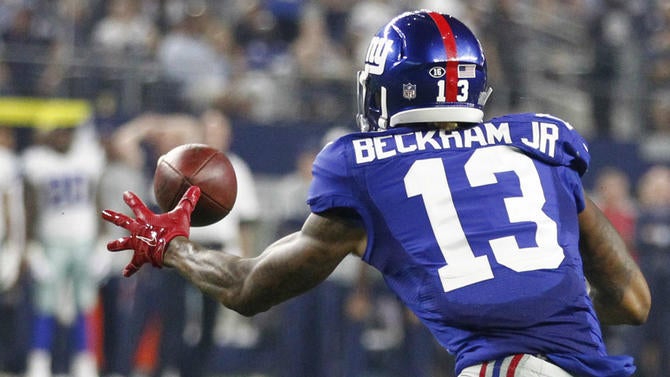
OBJ can beat cornerbacks deep or shallow, on in-breaking routes, hitches, slants, fades -- anything. Throw in the acrobatics and even in a division that includes the next guy we'll talk about, it's tough to say he's not the best player at his position in the NFC East.
There are four players since the AFL/NFL merger that have racked up at least three seasons of 88-plus catches, 1,200-plus receiving yards, and 12-plus touchdowns: Marvin Harrison, Jerry Rice, Terrell Owens, and Dez Bryant. Harrison, Rice, and Owens never hit those figures until after their age-27 seasons. Bryant did it three times in a row from ages 24 through 26.
If he's healthy enough to play, Dez is a pretty sure bet for an all-time year. With his foot healed, Romo back, and Elliott in the backfield, we're likely to see Dez throw up that X a bunch more times this season.
One could make an argument for Jackson's teammate Pierre Garcon in the third receiver spot here, but DeSean's downfield playmaking seems a bit more valuable than Garcon's closer-to-the-line-of-scrimmage exploits. Garcon's yards per catch figure has gone down in three straight seasons, falling from 14.4 all the way to 10.8, while Jackson's never had a season where he averaged less than 14.7 yards per catch. D-Jax also has more touchdown upside, having hit nine twice in his career. Garcon has never had more than six end zone dances.
Tight Ends: Jordan Reed, Washington; Zach Ertz, Eagles
Reed might very well have been the second-best tight end in football last season. Rob Gronkowski is the class of the league, of course, but Reed did a decent Gronk impression himself: he's 6-foot-3 and 236 pounds, and he rumbled through defenses to the tune of 87 catches, 952 yards, and 11 scores in 2015.
Reed had always been productive in his three-year career; the problem was he never stayed on the field before last year. The fact that he stayed healthy, and developed excellent chemistry with Cousins, led to a season where he averaged 6.2 catches for 68.0 yards per game, up from averages of solid averages of 4.8 for 48.2 in his first two campaigns (the equivalent of 77 catches for 771 yards in a 16-game season).
Jason Witten is a legend. He's a no-doubt future Hall of Famer. He's a metronome that can still be penciled in for 65-plus catches for 700-plus yards basically in his sleep. But Ertz's upward trajectory in terms of both his involvement in Philly's offense and his production, combined with his age (he's still only 25) make him the better bet for a better 2016 season.
Ertz has seen more targets, caught more passes (and a higher percentage of passes thrown to him), and racked up more receiving yards in each of his three seasons than he did the season before. That resulted in a 75-853-2 line last season, and if the Eagles finally decide to get a 6-foot-5, 249-pound tight end more involved in the red zone, that production should only get better.
Offensive Lineman: Tyron Smith, Cowboys; Jason Peters, Eagles; Zack Martin, Cowboys; Brandon Brooks, Eagles; Travis Frederick, Cowboys
Penciling in the three Cowboys here was pretty easy. Smith is arguably the best left tackle in football (it's him or Joe Thomas). He's been in the league five years and has made three Pro Bowls, an All-Pro first team, and two second teams ... and he is still somehow only 25 damn years old. His arms are some of the longest I've ever seen, and he just absolutely stonewalls rushers attempting to get to Romo around the edge. Throw in his massively improved run-blocking from his rookie year through Year 5, and it's impossible to take any tackle in the division over him.
Martin's career has gone about as well as one could possibly expect. After Stephen Jones convinced Jerry to take him over Johnny Manziel, all the former Notre Dame tackle has done is go 2-for-2 in making Pro Bowls and All-Pro teams in his two seasons (first team as a rookie and second team as a sophomore). If it wasn't for the existence of Marshal Yanda, Martin would have as good an argument as anybody for the title of best guard in the NFL. He, too, is only 25 years old.
Frederick is the youngest of the trio at 24 years old, but he's nearly as accomplished as his linemates. After the Cowboys were widely mocked for trading down in the 2013 draft and snatching him at the end of the first round, Frederick quickly established himself as an excellent run-blocking center as a rookie. The pass blocking and protection coordination has followed over the last two years, and he has made back-to-back Pro Bowls and All-Pro second teams in those seasons as well. Stop me if this sounds familiar, but he also might be the best player in the league at his position.
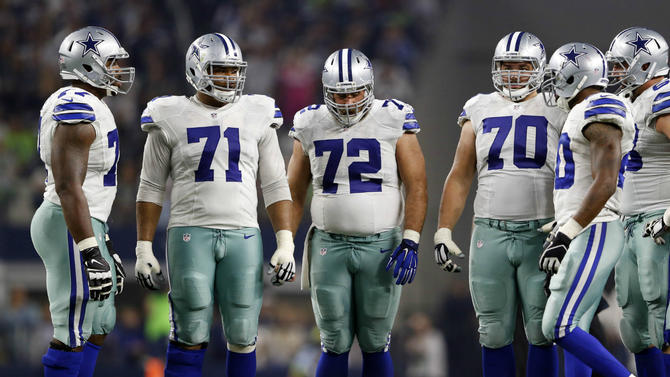
Peters is 34 years old, but he's basically ageless. He just turns out Pro Bowl season after Pro Bowl season, protecting the blindside of whomever the Eagles happen to have under center, and doing it as well as can reasonably be expected. He's on the field nearly every week. He missed the whole year in 2012 with a ruptured Achilles, but has otherwise played 92.5 percent of all possible games since 2005.
Brooks didn't have his best season in 2015, but his track record in Houston prior to that was as one of the NFL's top guards. The fact that he is an excellent pass-blocker should help an Eagles team that struggled badly with interior pressure last season while playing replacement-level players at the guard spots. Playing between Jason Kelce and Lane Johnson should help his performance get back to previous levels as well.
Defensive Ends: Olivier Vernon, Giants; Brandon Graham, Eagles
Vernon's track record as a high-level sack producer is not very long, but since becoming a starter in 2013 he has ranked very well in Pro Football Focus' pressure rate rankings (sacks plus hits plus hurries, divided by pass rushing attempts). When you consider the other candidates at defensive end in the division (basically, one-handed JPP and the two suspended Cowboys ends), he looks a lot more appealing.
Playing on the same line as Pierre-Paul, new defensive tackle Damon Harrison, and a guy we'll get to at the next position should also free Vernon from having to deal with any double-teams, which could lead to increased production, especially as he moves into his physical prime years.
Graham has been miscast for a few years as a 3-4 outside linebacker. Moving to defensive end in a 4-3 system (and hopefully seeing a more regular helping of snaps) will be good for him. Graham was on the field for 70.6 percent of Philadelphia's defensive snaps last season, up from 43.1 percent in 2014 and an astonishingly low 26.8 percent in 2013. And that was after he put up 5.5 sacks despite playing only 40.9 percent of snaps in 2012.
The trend is clear: if you put Graham on the field and let him loose, he will get after the quarterback. Jim Schwartz will put him in good position to do exactly that.
Defensive Tackles: Johnathan Hankins, Giants; Fletcher Cox, Eagles
Hankins was not at his best early in the 2015 season, then tore his pectoral muscle in Week 9 and was out for the rest of the year. We expect a big comeback season in 2016. He's still only 24 years old and he is now on a defensive line that has received some significant talent upgrades.
Hankins works extremely well against the run and during his breakout 2014 season also managed to notch seven sacks from his position on the interior defensive line. The addition of Harrison as a run-stuffer will free up Hankins to move to three-tech and get more pressure one-on-one against guards and centers that aren't as quick off the snap as he is.

Cox recently became a very well-compensated man ($102.6 million over the next six years sounds pretty nice), and with good reason. He finished the 2015 season with 9.5 sacks and also rated second in total pressures from a 3-4 end (behind only J.J. Watt), per Pro Football Focus.
Moving Cox inside even more (from 3-4 end to 4-3 tackle) should give him an even greater quickness advantage than he's had the last few years, allowing him to shoot a single gap with impunity rather than trying to two-gap at times. Jim Schwartz has had a ton of success letting interior rushers loose in his defense (see: Marcell Dareus and Ndamukong Suh) and Cox should be the next player in that line of big problems for offensive linemen.
Linebackers: Sean Lee, Cowboys; Ryan Kerrigan, Washington; Mychal Kendricks, Eagles; Jordan Hicks, Eagles
This was the toughest group of players to settle on, as the linebacker crop in the NFC East is not all that great. Lee is probably the single best player of any of them, but he's also not a safe bet to be on the field at all. He's been one of the best players at his position whenever he's on the field, but he's also missed 37.5 percent of all possible games since he entered the league.
When he's out there, though ... woo boy, is he good. Lee somehow made just his first Pro Bowl in 2015, despite the fact that he has career averages of nearly seven tackles a game and over three picks a season. If he can manage to stay on the field, he'll almost certainly be the best player on Dallas' defense yet again.
You know exactly what you're getting with Ryan Kerrigan. Washington's top pass-rusher is on the field every week -- he's played all 16 games in each of his five seasons. He has also sacked the quarterback at least 7.5 times in each of those five seasons, topping out with 13.5 in 2014. Here's the list of NFL players with at least 7.5 sacks in each of the last five seasons: Ryan Kerrigan. That's it. He's heading into his age-28 season, which means he's smack dab in the middle of his physical prime. Another quality year should be on tap.
The final two spots here came down to the Eagles almost by default (Rolando McClain is suspended for 10 games and none of the Giants linebackers is inspiring in any way whatsoever), but they're somewhat deserving based on their talent, as well. Kendricks didn't have his best season in 2015 (he was particularly rough in coverage), but his play the few years prior was much better. Hicks came in as a rookie and impressed right away, and should only get better with more experience.
Cornerbacks: Josh Norman, Washington; Bashaud Breeland, Washington; Orlando Scandrick, Cowboys
There are a ton of people that think Norman is overrated because he talks as much as he shows up on film. Add in Carolina's Cover-2 heavy defense and you've got a recipe for Richard Sherman-style criticism. Whether he's overrated or not, he's still really damn good, and that's what we're looking for here.
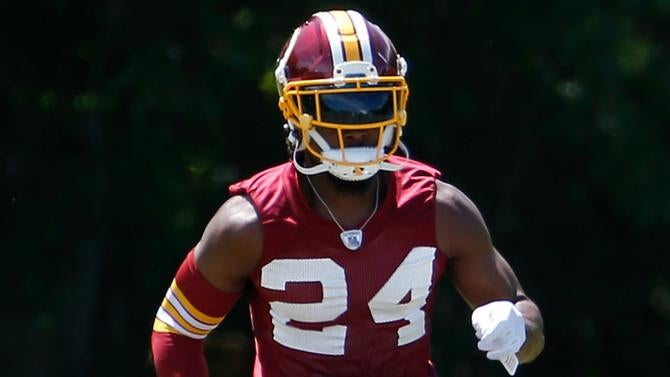
Just take a look at this:
| WEEK | WR | REC | TGT | YDS | TD | INT |
| 2 | DeAndre Hopkins | 2 | 7 | 24 | 0 | 0 |
| 4 | Vincent Jackson | 2 | 6 | 31 | 0 | 1 |
| 8 | T.Y. Hilton | 1 | 3 | 15 | 0 | 0 |
| 12 | Dez Bryant | 1 | 5 | 6 | 0 | 0 |
| 14 | Julio Jones | 4 | 6 | 33 | 0 | 0 |
| 15 | Odell Beckham | 4 | 7 | 30 | 1 | 0 |
| 16 | Julio Jones | 5 | 6 | 80 | 0 | 0 |
| 17 | Mike Evans | 1 | 5 | 15 | 0 | 0 |
| 2015 | TOTAL | 20 | 45 | 234 | 1 | 1 |
That's Norman shadowing seven of the NFL's best receivers and basically shutting them out of existence. Even if you added in that easy touchdown Beckham dropped on him to open the game in Week 14, it would still be ridiculous. The dude can play.
Breeland was probably Washington's best defensive player last season, and teaming him up with Norman gives Washington the definitive best corner tandem in the division. He finished the year with 81 tackles, 11 passes defenses, two picks, and three forced fumbles. Per Pro Football Focus, he allowed 50-plus yards only three times after Washington's bye week. Washington can easily play sides with him and Norman if it wishes, trusting that either player can handle No. 1 wideouts on a snap-to-snap basis.
Scandrick missed the entirety of last season with a torn ACL, but had blossomed into one of the NFL's best slot corners in the few seasons before that, while also showing the ability to work on the outside despite his smallish stature (5-foot-10, 192 pounds). In 2014, only seven corners had at least seven interceptions and passes defensed combined, and no touchdowns allowed. Scandrick was one of them. His return from injury is a welcome sign for the Cowboys, who basically employ turnstiles at the other two corner spots in Brandon Carr and Morris Claiborne.
Safeties: Malcolm Jenkins, Eagles; Rodney McLeod, Eagles
Byron Jones pushed for a spot here after a rookie season that saw him contribute all over the field, but the Eagles' back-end duo seems like it has a higher ceiling given that they will be playing with a strong group in front of them.

Jenkins' star has only risen since moving from New Orleans to Philadelphia, and he made his first Pro Bowl last season. He can move all over the field, playing in the box or up high, and even sliding over to the slot to cover receivers there, as he did with great success for much of last season. He also contributed in a big way in the running game.
McLeod is coming over to Philly after spending the first four years of his career with the Rams. Here's how one NFC West scout described him at the time he signed his new contract:
Evaluation of Rodney McLeod from NFC West senior scout: pic.twitter.com/PC1nTYZkoj
— Jeff McLane (@Jeff_McLane) March 9, 2016
He was described by the same scout as "tough as s--- ," which is an awesome thing to be when your job is to hit people. He'll probably play the deep safety role for Philly, patrolling the back end while Jenkins roams all over. That's a great fit.









